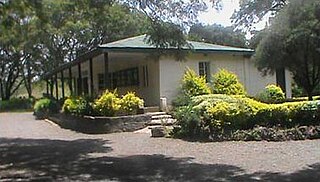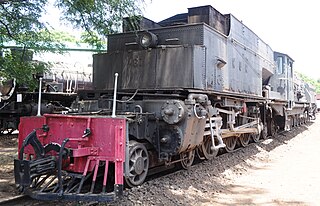 W
WThis is a list of museums in Kenya. Many of these national and provincial museums are administered by the National Museums of Kenya (NMK).
 W
WThe Abasuba Community Peace Museum was founded in 2000, is located in Ramba, Waware, Suba North District, Homa Bay County, Kenya.
 W
WBomas of Kenya is a tourist village in Langata, Nairobi. Bomas (homesteads) displays traditional villages belonging to the several Kenyan tribes. Bomas of Kenya is home to one of largest auditorium in Africa. It is located approximately 10km from the Central Business District.
 W
WThe National Museums of Kenya (NMK) is a state corporation that manages museums, sites and monuments in Kenya. It carries out heritage research, and has expertise in subjects ranging from palaeontology, ethnography and biodiversity research and conservation. Its headquarters and the National Museum are located on Museum Hill, near Uhuru Highway between Central Business District and Westlands in Nairobi. The National Museum of Kenya was founded by the East Africa Natural History Society (E.A.N.H.S.) in 1910; the Society's main goal has always been to conduct an ongoing critical scientific examination of the natural attributes of the East African habitat. The museum houses collections, and temporary and permanent exhibits. Today the National Museum of Kenya manages over 22 regional museums, many sites, and monuments across the country.
 W
WFort Jesus is a fort located on Mombasa Island. Designed by Italian Giovanni Battista Cairati, it was built between 1593 and 1596 by order of King Felipe II of Castille, who also reigned as King Filipe I of Portugal and the Algarves, to guard the Old Port of Mombasa. Fort Jesus was the only fort maintained by the Portuguese on the Swahili coast, and is recognised as a testament to the first successful attempt by a Western power to establish influence over the Indian Ocean trade.
 W
WThe Hyrax Hill site was proclaimed a national monument in 1945 and opened to the public in 1965. This was as a result of startling discoveries of relics by Mrs. Selfe and subsequent archaeological excavations that were carried out by Dr. Mary Leakey in 1938 that revealed substantial findings in different areas of the site and levels of occupations. The late Mrs. Selfe was the owner of the property. The renovation of archaeology exhibit was made possible through the kind sponsorship of Kenya Museum Society and consultation of British Institute in Eastern Africa in collaboration with the National Museums of Kenya. The hill comprises particular importance due to the fact that it encompasses several phases of occupation; it also has a long history of archaeological investigation, which began in 1937 with Mary Leakey.
 W
WThe Kabarnet Museum is a museum located in Kabarnet, Kenya. It features galleries relating to the Great Rift Valley and its peoples, including the Keiyo / Marakwet, Samburu, Pokot, Nandi and Kipsigis.
 W
WThe Kapenguria Museum is a museum located in Kapenguria, Kenya. The museum is located inside the prison where prominent leaders of the Kenyan independence movement were held and put on trial in 1952/3. The museum features galleries in the former cells of the prison, including displays on these leaders and the struggle against colonialism, and houses a memorial library in their honour.
 W
WThe Kisumu Museum is a museum located in Kisumu, Kenya. Its exhibits focus on the natural and cultural history of Western Kenya. It features a collection of local flora and fauna, as well as a traditional Luo homestead.
 W
WFirst opened in 1924 to the public, the Kitale Museum is the first domestic museum opened in Kenya. Originally known as the Stoneham Museum, which was named after Colonel Hugh Stoneham who had been a large contributor and collector of the artifacts held within the museum up until his death in 1966. It was later renamed the Kitale Museum when it was established by the National Museums of Kenya in 1974.
 W
WThe Malindi Museum is a museum located in Malindi, Kenya. The museum is dedicated to the history of the ethnic groups of the Kenyan coast as well as the marine animals that inhabit it.
 W
WThe Nairobi Gallery is an art gallery located in the capital of Kenya. The gallery is dedicated to showcasing African art.
 W
WThe National Museums of Kenya (NMK) is a state corporation that manages museums, sites and monuments in Kenya. It carries out heritage research, and has expertise in subjects ranging from palaeontology, ethnography and biodiversity research and conservation. Its headquarters and the National Museum are located on Museum Hill, near Uhuru Highway between Central Business District and Westlands in Nairobi. The National Museum of Kenya was founded by the East Africa Natural History Society (E.A.N.H.S.) in 1910; the Society's main goal has always been to conduct an ongoing critical scientific examination of the natural attributes of the East African habitat. The museum houses collections, and temporary and permanent exhibits. Today the National Museum of Kenya manages over 22 regional museums, many sites, and monuments across the country.
 W
WThe Nairobi Railway Museum is a railway museum in Nairobi, Kenya, adjacent to Nairobi railway station. Containing exhibits from the defunct East African Railways, it was opened in 1971 by East African Railways and Harbours Corporation. It is operated by Kenya Railways.
 W
WThe National Museums of Kenya (NMK) is a state corporation that manages museums, sites and monuments in Kenya. It carries out heritage research, and has expertise in subjects ranging from palaeontology, ethnography and biodiversity research and conservation. Its headquarters and the National Museum are located on Museum Hill, near Uhuru Highway between Central Business District and Westlands in Nairobi. The National Museum of Kenya was founded by the East Africa Natural History Society (E.A.N.H.S.) in 1910; the Society's main goal has always been to conduct an ongoing critical scientific examination of the natural attributes of the East African habitat. The museum houses collections, and temporary and permanent exhibits. Today the National Museum of Kenya manages over 22 regional museums, many sites, and monuments across the country.
 W
WThe ruins of Gedi are a historical and archaeological site near the Indian Ocean coast of eastern Kenya. The site is adjacent to the town of Gedi in the Kilifi District and within the Arabuko-Sokoke Forest.